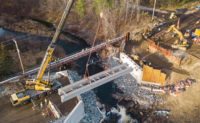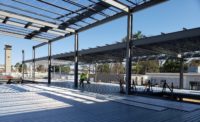Crews are set to begin paving, landscaping and other final work on April 19 for the $7 million Bridge Street Bridge replacement project in Gardiner, Maine—the city’s second accelerated slab and girder bridge construction project. The team relocated a major utility duct bank before laterally sliding the 700-ton single span structure onto its foundation last fall.
Consolidated Communication’s major utility duct bank and trunk line from their central office—located less than a block away—cross the bridge. “That feeds central Maine for telecommunications so they could not take any outage,” says Tim Merritt, principal for Stantec, engineer of record for the bridge projects.
The 135-ft-long by 60-ft 4-in-wide Bridge Street Bridge, that carries U.S. Route 201 over the Cobbosseecontee Stream was completed in downtown Gardiner in 2020, replacing a deteriorated 103-year-old bridge.
The project is part of the city’s $12.7 million Comprehensive Transportation Improvement Project, scheduled for completion in June. In addition to the Bridge Street Bridge, it includes the nearby $2.9 million Maine Ave. Bridge replacement, $1.1 million for a multi-use recreational bridge for cyclists and pedestrians that connects with the Kennebec River Rail Trail and $0.63 million for traffic signal and utility coordination.
The annual average daily traffic on the Bridge Street Bridge is about 14,500 vehicles per day and Maine Ave. is about 9,000, according to MaineDOT.
Novel Slide
The Bridge Street Bridge lateral slide of a 700-ton-single-span structure took place during a 30 day closure last November, only the second lateral slide effort in the state since construction of the Littlefields Bridge over the Adroscoggin River in 2013, recalls Wayne Frankhauser, bridge program manager at MaineDOT.
Unlike other, more common, bridge slide in procedures, this slide required the team to raise up the duct bank and reattach it to the new bridge, Merritt notes.
“Every state has done a few of these slide ins, but one of the unique aspects of this slide in is that we slid over a major utility and then raised it [the duct bank] up and attached it to the bridge—all while the utility was still in service and they didn’t have to take any outage,” Merritt says.
Reed & Reed Inc., the Woolwich, Maine-based general contractor demolished the old bridge and, using rails “slid the new bridge over onto the new foundations,” which had been constructed earlier, says Merritt.
Demolition required crews to work 24 hours a day 7 days a week, said Chris Clark, project manager for Reed & Reed.
“Our crews were tired,” he says. “We brought in another superintendent that oversaw the slide jacking process who had just finished another project in Ossippee, N.H. so we had a fresh pair of eyes and someone with the experience to direct the crews.”
The slide was accomplished in 7.5 hours before the bridge was jacked off the rollers down onto the bearings, Clark says. Jacking the following day took 4.5 hours with set up taking longer than the actual jacking. “The slide involves an open-core jack that pulls a dywidag rod that pulls the bridge into place; it’s time-consuming because you can only thread so much, working in sections before you have to take a piece of thread rod off, reset the jacks and start pulling again.”
Stantec devised a scheme to widen the existing bridge to add an additional lane and shoulder width, enabling them to build a new duct bank on the west side outside the existing bridge footprint on temporary support, Merritt says. Meanwhile on the east side, “we built the top half of the new bridge on temporary support off to the side” where a pizza restaurant had been acquired by the state and demoed while maintaining traffic on the existing bridge, he notes.
Stantec was able to keep an elevated rail car diner open for business in the midst of construction with the exception of a 30-day closure. The diner was suspended on a steel lattice structure and attached to the east side of the existing bridge.
Innovative solution
Both Bridge St. and Maine Ave. bridges are situated close to the confluence with the Kennebec River, where construction is restricted from November to March to protect endangered Atlantic salmon and sturgeon spawning and migration, Merritt notes. To avoid these restrictions, Stantec developed innovative solutions, including designing foundations that allowed the contractor to largely work on dry land in low tide.
“That gave crews a window each day that wasn’t considered in-stream work,” Merritt says. The firm also designed the Maine Ave. bridge to be longer than necessary to enable drawing back the foundations from the water, Merritt says.
The Maine Ave. single span bridge on Route 24, which crosses the Cobbosseecontee Stream, replaced a deteriorating 87-year-old bridge in 2019 with a 78-ft-long by 40 ft 4- in-wide replacement bridge during a 13-day closure. Incentive for the Maine Ave. Bridge was $30,000 a day up to $120,000 and disincentive was $30,000 a day uncapped. Reed & Reed Inc. has received $60,000 in incentive for finishing the Maine Ave. Bridge closure two days early, according to the MaineDOT.
It turned out that doing a full closure of the smaller Maine Ave. bridge had a bigger traffic impact due to how Maine Ave. ties into a signalized traffic intersection to the north, Merritt said.
Crews drove piles into the ground ahead of the full bridge closure, he said. “We constructed the abutment out of precast concrete onsite rather than offsite.”
Since the area has many pedestrians, the team opted to build a separate 76-ft long multi-use bridge first and opened that as a pedestrian crossing across the street during the 13-day closure, Merritt says.
In Portland, Maine, another lateral slide will take place this spring, for the $20.8 million Veranda Street Bridge replacement project, which carries traffic over I-295 according to MaineDOT. The project which began on March 8 will require a 60-hour closure of the interstate while Cianbro, the contractor, constructs the new bridge on the east side of the existing bridge and slides the new bridge into place.






Post a comment to this article
Report Abusive Comment